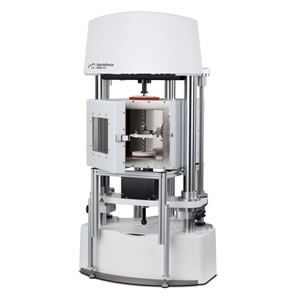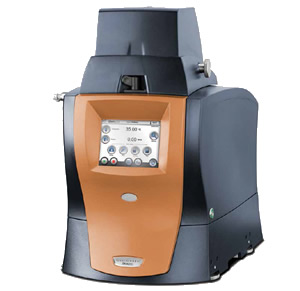View DMA Brochure DMA Accessories Request a Quote
Dynamic Mechanical Analysis measures the mechanical properties of materials as a function of time, temperature, and frequency. In addition to quantifying viscoelastic properties of materials, DMA can also quantify finished component and product characteristics, reflecting the important contribution that processing has on end-use product performance. DMA is commonly used to measure glass transition temperatures (Tg) and secondary transitions, orientation caused by processing, cold crystallization, cure optimization, filler effects in composites, and much more. DMA provides an accurate measure of material modulus and product stiffness plus other important mechanical properties such as damping, creep, and stress relaxation.
A Dynamic Mechanical Analyzer is a mechanical instrument that applies specific displacement or force to a sample and very accurately quantifies its force versus displacement response. Its measurements extend beyond simply quantifying the magnitude of force divided by the displacement magnitude; it accurately calculates the phase relationship between the signals. This enables a DMA instrument to quantify the elastic (spring-like) versus viscous (fluid-like) components of the sample response which is crucial for reliable and complete viscoelastic property characterization such as Storage Modulus, Loss Modulus, and Tan delta. These viscoelastic properties are almost always evaluated over a range of temperatures, using oven and cooling accessories, which then can provide many insights into structure-property relationships and how materials perform at different use temperatures. Some advanced methods include TTS (Time-Temperature Superposition), curing studies, creep-recovery, and stress-relaxation analysis.
The wide range of TA Instruments | Waters Dynamic Mechanical Analyzers is not only the best-selling in the world, but also covers the widest range of forces and applications. The best-selling DMA850 delivers an incredible wide range of force measurements from 0.1 mN to 18 N and with the One-Touch-Away interface, DMA Express mode is the easiest and most often used method to evaluate glass transitions and secondary transitions of solid materials. It also enables characterization of the effects of humidity. The RSA-G2 is a research-grade DMA that delivers up to 35 N of force, a dielectric stimulation accessory, and offers a high-precision Force Convection Oven (FCO) for stable and fast ramping temperature control. Finally, TA Instruments’ series of High-Force DMA instruments extend the insights revealed by DMA to higher forces and samples sizes, providing valuable insights when materials cannot be miniaturized or for components or products that are larger in size. They also add highly durable and fast fatigue test methods, delivering as much as 15,000 Newtons of force in the largest HF-DMA model.
Common Testing Standards
- ISO 4664 – Rubber, vulcanized or thermoplastic — Determination of dynamic properties
- ISO 4666 – Rubber, vulcanized — Determination of temperature rise and resistance to fatigue in flexometer testing
- ISO 6721 – Plastics — Determination of dynamic mechanical properties
- ASTM D623 – Plastics DMA: Standard Practice for Plastics: Dynamic Mechanical Properties: Determination and Report of Procedures
- ASTM D4065 – Plastics DMA: Standard Practice for Plastics: Dynamic Mechanical Properties: Determination and Report of Procedures
- ASTM D4473 – Standard Test Method for Plastics: Dynamic Mechanical Properties: Cure Behavior
- ASTM D5023 – DMA testing: Standard Test Method for Measuring the Dynamic Mechanical Properties: In Flexure (Three-Point Bending)
- ASTM D5024 – Standard Test Method for Plastics: Dynamic Mechanical Properties: In Compression
- ASTM D5026 – Standard Test Method for Plastics: Dynamic Mechanical Properties: In Tension
- ASTM D5418 – Standard Test Method for Plastics: Dynamic Mechanical Properties: In Flexure (Dual Cantilever Beam)
- ASTM D5992 – Rubber testing: Standard Guide for Dynamic Testing of Vulcanized Rubber and Rubber-Like Materials Using Vibratory Methods
- ASTM D7028 – Standard Test Method for Glass Transition Temperature (DMA Tg) of Polymer Matrix Composites by Dynamic Mechanical Analysis (DMA)
- ASTM E1640 – DMA testing: Standard Test Method for Assignment of the Glass Transition Temperature By Dynamic Mechanical Analysis
- DIN 53513 – Determination of the viscoelastic properties of elastomers on exposure to forced vibration at non-resonant frequencies
- DIN 53533 – Testing of elastomers; testing of heat generation and service life during the fatigue test
Dynamic Mechanical Analyzers
Application Notes
- Introduction to Dynamic Mechanical Analysis and its Application to Testing of Polymer Solids
- Characterizing Hydrogels using Dynamic Mechanical Analysis Methods
- Sustainable Tire Rubber – A Comparison of Silica and Carbon Black Filled Tread Compounds Using DMA
- Thermal Analysis of Battery Separator Film
- Battery Separator Film Development: Impact of Coating
- Determination of the Linear Viscoelastic Region of A Polymer Using a Strain Sweep on the DMA 2980




